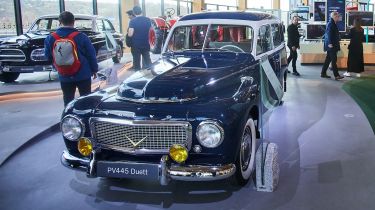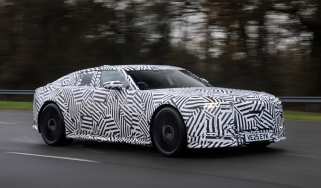World of Volvo: the essential museum trip for fans of Sweden’s beloved boxy car brand
We make a trip to Sweden to visit Volvo’s new museum and experience centre in Gothenburg
Car brands like to be seen as a lot more than just purveyors of shiny metal nowadays. If you succumb to all the marketing materials, you’ll see Ford as a representation of the birth of mass production in the automotive industry, Volkswagen as a showcase for Germany’s progression from a totalitarian dictatorship to a democratic social market economy and Ferrari as the embodiment of luxury, passion and performance.
Volvo, on the other hand, likes to see itself as the brand of car safety, and this is what it’s trying to convey in the new World of Volvo museum, which opened its doors earlier this year in the heart of Gothenburg, Sweden.
Of course, this assertion isn’t without any precedent; Volvo has long been at the forefront of car-safety development. For example, the brand was the first to offer a traditional three-point seatbelt way back in 1959 – a fact it still proudly displays on the tongue of its cars’ belts to this day. In the early nineties, Volvo also introduced its Side Impact Protection System (SIPS), a reinforced side crash structure that was eventually bolstered by the world’s first side-impact airbags. The brand’s innovations have continued into the digital age of driver- assistance tech, too, with the 2008 Volvo XC60 being the first new car sold with autonomous emergency braking – something that’s now mandatory on all new cars sold in the UK.
The museum is a technological marvel itself; four years in the making, World of Volvo spans a colossal 22,000sqm. The building centres around three 34-metre-high wooden tree trunk-like structures, which branch out at the top to support the vast ceiling and walls of glass. It’s a space built on the Swedish concept of allemansrätt, which means every person has a right to access nature. The architects have described the trio of ‘trees’ as featuring a “forest-like canopy” – a remark we initially rolled our eyes at until we realised that atop the entire building sits an impressive rooftop garden.
This vibrant greenery puts the museum in stark contrast to the rest of Gothenburg as a city, which, unlike the rest of Sweden, is a shrine to all things stone and concrete, with its vast industrial district, skyscrapers and inner-city theme park.
We speak to the museum’s CEO, Magnus Wrahme, who tells us that Volvo as a brand felt that it owed it to the city to provide not only a popular tourist attraction, but also an inviting space for residents to spend time. “There’s a passion to work inside Gothenburg,” Wrahme says. “We’ve been outside of the city for too long and we want people to feel at home [here]. It’s a good way to give back”.
That’s all fair enough, but what does it have to do with safety or Volvo as a brand? Well, what makes this more than simply your run-of-the-mill car museum – aside from World of Volvo’s state-of-the-art architecture, two restaurants and private concert hall – is the exhibition on car safety. This explores what environmental and psychological factors contribute to a crash, what impact being in an accident has, and the technology being developed to prevent it.
The exhibition is full of interactive displays which intend to fully immerse and engage visitors, from a simulator that mimics the sensation of standing in a bus when it does an emergency stop, to an air tunnel that can determine how aerodynamic (or not) your face is. Granted, a few of the exhibits may be a little highfalutin for some – we're not all too sure about the dark room with walls projected with background graphics seemingly from a nineties PlayStation game, supposedly representing the way safety systems see the world around us – but there should be something to interest almost everyone. Unfortunately, to the dismay of our inner seven-year-old, the interactive Volvo digger exhibit was not open during our visit.
Ultimately, it’s the cars that are the main draw here and World of Volvo has an impressive collection of more than 50 vehicles. We’re taken on a tour by heritage manager Hans Hedberg, who gives us detailed explanations of all of the cars on display, from Volvo’s first model, the 1927 ÖV4, to one of the very few surviving Volvo White Buses from WW2. The museum even has the last-ever Mk1 Volvo XC90 ever produced. Each vehicle in the collection gets a handy little plaque with a brief rundown on the car and a QR code that brings you to a custom web page with even more information.
We’ve compiled a list of our personal highlights of the museum, however it’s worth noting that the exhibitions are constantly changing; Hedberg explains that Volvo has well over 200 models in its heritage collection, so you can visit the museum more than once and whatever was on display may have changed.
What may be the biggest draw for some, however, will be the ability to pick up their brand-new Volvo model from a special handover bay near the museum entrance.
Yes, that’s right: American Volvo customers will, for a cost, soon be able to fly over to Sweden to pick up their new set of wheels from World of Volvo. Owners will then be able to explore Europe at their leisure, before having their car shipped home. We asked Volvo whether this would ever be offered for the UK market; while there were talks before the Covid pandemic, nothing has been confirmed.
Regardless of whether you’re a Volvo customer, a car fanatic or just in the local area, World of Volvo is a must-do for any visit to Gothenburg or Scandinavian road trip. It’s more than just a car museum: it’s a beautifully curated collection of interesting, entertaining and thought-provoking exhibits that intend to display Volvo’s standing as not only an automotive brand, but also one of lifestyle, heritage and future technology. Oh, and it’s got a pretty neat gift shop, too.
Museum Highlights
World’s highest-mileage car
You might expect the world’s highest-mileage car to be some sort of diesel repmobile along the lines of a Vauxhall Insignia or Ford Mondeo. However, it’s actually a Volvo P1800 sports car, once owned by American school teacher Irv Gordon. Since buying it from new all the way back in 1966, Gordon drove his car a total of 3.2 million miles – the equivalent of three round trips to the Moon. After passing away in November 2018, Gordon left his beloved P1800 to Volvo, once having jokingly offered to sell it back to the brand for “$1 per mile” driven.
‘Adventure in Distractville’
This is Volvo’s take on an arcade racer, along the same lines as OutRun or SEGA Rally. However, the goal here isn’t to drive as fast as you can, but as safely as possible. Glenn, a wittering Muppet-like creature, makes that very hard, though, because he attempts to take your eyes off the road by asking you to do things like turn on the headlights or change the radio station. It’s a lot of fun and a big reminder of how seemingly harmless activities such as listening to a conversation or adjusting car functions – especially with today’s touchscreens – can result in a momentary loss of concentration.
Volvo Experimental Safety Car
You might wonder whether this Volvo concept car, with its enlarged front and rear, has been designed by the Kardashians. It’s actually the result of a brief given to Volvo’s engineers all the way back in the early seventies. With only three examples produced, the VESC got tech deemed futuristic at the time, such as anti-lock brakes, pre-tensioning three-point seatbelts, airbags and one of the world’s first reversing cameras. The designers even went as far as drawing lines on the bonnet to guide the eyes of the driver, while the aforementioned giant bumpers could withstand crashes of up to 50mph.
Volvo White Bus
Volvo is an integral part of Swedish history, and the White Bus on display in World of Volvo is a poignant reminder of that. Towards the end of the Second World War, an operation was conducted by the Swedish Red Cross to rescue over 30,000 prisoners of war interned in Nazi concentration camps with 36 buses. The campaign has seen controversy in recent years; negotiations to release prisoners were partially instigated by the Nazis themselves in order to be seen in a more positive light, and Sweden’s original goal was only to rescue Swedish and Danish prisoners of war. Nevertheless, the relief effort went on to save people of all races, religions and nationalities.
How to Visit
- Return flight from LHR to GOT: from £80
- Average price per night for 3* hotel: from 1,150SEK (£83)
- Admission: from 180SEK (£13)
- Address: World of Volvo AB, Lyckholms Torg 1, 412 63 Gothenburg
Which classic Volvo is your favourite? Tell us in the comments section below...
Find a car with the experts









